|
All Input Is Evil!
-Writing secure code |
在寫前幾篇文章的時候,有些朋友建議我的寫一篇關于表單數據校驗的文章。 正如文章的開頭所引用的《Writing Secure Code》的名言:“所有的輸入都是罪惡的”,所以我們應該對所有的外部輸入進行校驗。而表單是應用程序最簡單的入口,對其傳進來的數據,我們必須進行校驗。
轉換與校驗(Conversion & Validation)
其實上篇文章,我本來是打算寫表單數據校驗的內容,但是經過再三思考后,還是決定先寫Struts 2.0轉換器的內容。原因是我認為轉換是校驗的基礎,只有在數據被正確地轉換成其對應的類型后,我們才可以對其取值范圍進行校驗。看個例子相信大家可以更清楚。現在我們就來改造一下《轉換器(Converter)——Struts 2.0中的魔術師》的第一個例子。
首先,從Action開始,修改后的代碼如下:
 package
tutorial;
package
tutorial;
 import
java.util.Locale;
import
java.util.Locale;
 import
com.opensymphony.xwork2.ActionSupport;
import
com.opensymphony.xwork2.ActionSupport; import
com.opensymphony.xwork2.util.LocalizedTextUtil;
import
com.opensymphony.xwork2.util.LocalizedTextUtil;
 public
class
HelloWorld
extends
ActionSupport
{
public
class
HelloWorld
extends
ActionSupport
{ ? ?
private
String msg;
? ?
private
String msg; ? ?
private
Locale loc
=
Locale.US;
? ?
private
Locale loc
=
Locale.US; ? ?
? ? ? ?
public
String getMsg()
{
? ?
public
String getMsg()
{ ? ? ? ?
return
msg; ? ? ? ?
? ? ? ?
return
msg; ? ? ? ? ? ?}
? ?}
 ? ?
? ? ? ?
public
Locale getLoc()
{
? ?
public
Locale getLoc()
{ ? ? ? ?
return
loc;
? ? ? ?
return
loc; ? ?}
? ?}
 ? ?
? ? ? ?
public
void
setLoc(Locale
loc)
{
? ?
public
void
setLoc(Locale
loc)
{ ? ? ? ?
this
.loc
=
loc;
? ? ? ?
this
.loc
=
loc; ? ?}
? ?}
 ? ?
? ? ? ?@Override
? ?@Override ? ?
public
void
validate()
{
? ?
public
void
validate()
{ ? ? ? ?System.out.println(
"
Calling validate()
? ? ? ?System.out.println(
"
Calling validate() "
);
"
); ? ? ? ?
if
(
!
(loc.equals(Locale.US)
||
loc.equals(Locale.CHINA)))
{
? ? ? ?
if
(
!
(loc.equals(Locale.US)
||
loc.equals(Locale.CHINA)))
{ ? ? ? ?
? ? ? ? ? ?addFieldError(
"
loc
"
, getText(
"
validation.loc
"
));
? ? ? ?
? ? ? ? ? ?addFieldError(
"
loc
"
, getText(
"
validation.loc
"
)); ? ? ? ?}
? ? ? ?}
 ? ?}
? ?}
 ? ? ? ?
? ? ? ? ? ?
public
void
validateExecute()
{
? ?
public
void
validateExecute()
{ ? ? ? ?System.out.println(
"
Calling validateExecute() by reflection
? ? ? ?System.out.println(
"
Calling validateExecute() by reflection "
);
"
); ? ?}
? ?}
 ? ?
? ? ? ?@Override
? ?@Override ? ?
public
String execute()
{
? ?
public
String execute()
{ ? ? ? ?System.out.println(
"
Calling execute()
? ? ? ?System.out.println(
"
Calling execute() "
);
"
); ? ? ? ?
//
LocalizedTextUtil是Struts 2.0中國際化的工具類,<s:text>標志就是通過調用它實現國際化的
? ? ? ?
//
LocalizedTextUtil是Struts 2.0中國際化的工具類,<s:text>標志就是通過調用它實現國際化的
 ?? ?? ? ? ?msg
=
LocalizedTextUtil.findDefaultText(
"
HelloWorld
"
, loc);
?? ?? ? ? ?msg
=
LocalizedTextUtil.findDefaultText(
"
HelloWorld
"
, loc); ? ? ? ?
return
SUCCESS;
? ? ? ?
return
SUCCESS; ? ?}
? ?}
 }
}
然后,修改Struts.xml中Action的定義指明輸入地址:
? ? < result > /HelloWorld.jsp </ result >
? ? < result name ="input" > /HelloWorld.jsp </ result >
</ action >
接著,在HelloWorld.jsp中加入錯誤提示:
<% @taglib prefix = " s " uri = " /struts-tags " %>
< html >
< head >
? ? < title > Hello World </ title >
</ head >
< body >
? ? < div style ="color:red;" >
? ? ? ? < s:fielderror />
? ? </ div >
? ? < s:form action ="HelloWorld" theme ="simple" > ? ? ? ? ? ?
? ? ? ? Locale: < s:textfield name ="loc" /> < s:submit />
? ? </ s:form > ? ?
? ? < h2 >< s:property value ="msg" /></ h2 >
</ body >
</ html >
再修改LocaleConverter.java文件,將內容改為:
 package
tutorial;
package
tutorial;
 import
java.util.Locale;
import
java.util.Locale; import
java.util.Map;
import
java.util.Map; import
java.util.regex.Pattern;
import
java.util.regex.Pattern;
 public
class
LocaleConverter
extends
ognl.DefaultTypeConverter
{
public
class
LocaleConverter
extends
ognl.DefaultTypeConverter
{ ? ?@Override
? ?@Override ? ?
public
Object convertValue(Map context, Object value, Class toType)
{
? ?
public
Object convertValue(Map context, Object value, Class toType)
{ ? ? ? ?
if
(toType
==
Locale.
class
)
{ ? ? ? ? ? ?
? ? ? ?
if
(toType
==
Locale.
class
)
{ ? ? ? ? ? ? ? ? ? ? ? ?System.out.println(
"
Converting String to Locale
? ? ? ? ? ?System.out.println(
"
Converting String to Locale "
);
"
); ? ? ? ? ? ?String locale
=
((String[]) value)[
0
];
? ? ? ? ? ?String locale
=
((String[]) value)[
0
]; ? ? ? ? ? ?
return
new
Locale(locale.substring(
0
,
2
), locale.substring(
3
));
? ? ? ? ? ?
return
new
Locale(locale.substring(
0
,
2
), locale.substring(
3
)); ? ? ? ?}
else
if
(toType
==
String.
class
)
{
? ? ? ?}
else
if
(toType
==
String.
class
)
{ ? ? ? ? ? ?System.out.println(
"
Converting Locale to String
? ? ? ? ? ?System.out.println(
"
Converting Locale to String "
);
"
); ? ? ? ? ? ?Locale locale
=
(Locale) value;
? ? ? ? ? ?Locale locale
=
(Locale) value; ? ? ? ? ? ?
return
locale.toString();
? ? ? ? ? ?
return
locale.toString(); ? ? ? ?}
? ? ? ?}
 ? ? ? ?
return
null
;
? ? ? ?
return
null
; ? ?}
? ?}
 }
}
之后,修改國際化資源文件,內容為:
invalid.fieldvalue.loc = Locale必須為\ " xx_XX\ " 的格式
validation.loc = 區域必須為中國或美國
invalid.fieldvalue.loc = Locale must like \ " xx_XX\ "
validation.loc = Locale must be China or USA
發布運行應用程序,在瀏覽器中鍵入http://localhost:8080/Struts2_Validation/HelloWorld.action,在Locale中輸入zh_CN,按“Submit”提交,效果如上篇文章所示。而在服務器控制臺有如下輸出:
Calling validateExecute() by reflection...
Calling validate()...
Calling execute()...
Converting Locale to String...
上述的輸出說明了Struts 2.0的數據校驗工作方式,它需要經過下面幾個步驟:
- 通過轉換器將請求參數轉換成相應的Bean屬性;
- 判斷轉換過程是否出現異常。如果有,則將其保存到ActionContext中,conversionError攔截器再封裝為fieldError;如果沒有,進行下一步;
- 通過反射(Reflection)來調用validateXxx()方法(其中,Xxx表示Action的方法名);
- 調用validate()方法;
- 如果經過上述步驟沒有出現fieldError,則調用Action方法;如果有,則會跳過Action方法,通過國際化將fieldError輸出到頁面。
不喜歡看文字的朋友,可以參考下面的圖1。

圖1 校驗順序圖
看到這里可能大家會疑問:“這么多地方可以校驗表單數據,到底我應該在那里做呢?”有選擇是好事,但抉擇的過程往往是痛苦的,往往讓人不知所措。如果大家參照以下幾點建議,相信會比較容易地做出正確的抉擇。
- 如果需要轉換的數據,通常做法在轉換的時候做格式的校驗,在Action中的校驗方法中校驗取值。假如用戶填錯了格式,我們可以通過在資源文件配置invalid.fieldvalue.xxx(xxx為屬性名)來提示用戶正確的格式,不同的階段出錯顯示不同的信息。具體做法請參考上面的例子;
- 至于用validate()還是validateXxx(),我推薦使用validate()。原因是validateXxx()使用了反射,相對來說性能稍差,而validate()則是通過接口com.opensymphony.xwork2.Validateable調用。當然如果你的表單數據取值是取決于特定Action方法,則應該使用validateXxx()。
在運行上面的例子時,在Locale中輸入zh并提交時出現圖2所示頁面。
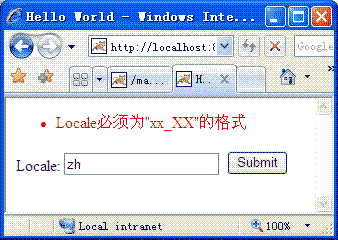
圖2 錯誤格式
在Locale中輸入de_DE時,出現如圖3所示頁面。
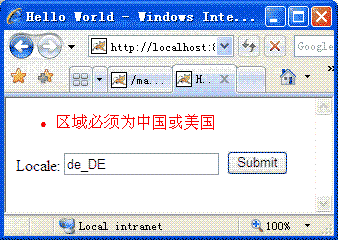
圖3 取值錯誤
使用Struts 2.0的校驗框架
上一節的內容都是關于如何編程實現校驗,這部分工作大都是單調的重復。更多情況下,我們使用Struts 2.0的校驗框架,通過配置實現一些常見的校驗。
我學習編程有個習慣——喜歡先看輸出結果,再看代碼實現。這樣學的好處是先看結果可以刺激學習的激情,也可以在看代碼前自已思考一下如何實現,然后帶著問題去看代碼,那就清晰多了。因此下面我們先來做演示。
首先,在tutorial包下新建ValidationAction.java,代碼如下:
 package
tutorial;
package
tutorial;
 import
com.opensymphony.xwork2.ActionSupport;
import
com.opensymphony.xwork2.ActionSupport;
 public
class
ValidationAction
extends
ActionSupport
{
public
class
ValidationAction
extends
ActionSupport
{ ? ?
private
String reqiuredString;
? ?
private
String reqiuredString;
 ? ?
public
String getReqiuredString()
{
? ?
public
String getReqiuredString()
{ ? ? ? ?
return
reqiuredString;
? ? ? ?
return
reqiuredString; ? ?}
? ?}

 ? ?
public
void
setReqiuredString(String
reqiuredString)
{
? ?
public
void
setReqiuredString(String
reqiuredString)
{ ? ? ? ?
this
.reqiuredString
=
reqiuredString;
? ? ? ?
this
.reqiuredString
=
reqiuredString; ? ?}
? ?}
 ? ?
? ? ? ?@Override
? ?@Override ? ?
public
String execute()
{
? ?
public
String execute()
{ ? ? ? ?
return
SUCCESS;
? ? ? ?
return
SUCCESS; ? ?}
? ?
? ?}
? ? }
}
然后,配置上述所建的Ation,代碼片段如下:
? ? < result > /Output.jsp </ result >
? ? < result name ="input" > /Input.jsp </ result >
</ action >
接著,創建Input.jsp和Output.jsp,內容分別如下:
<% @taglib prefix = " s " uri = " /struts-tags " %>
< html >
< head >
? ? < title > Hello World </ title >
? ? <!-- 此標志的作用是引入Struts 2.0的常用的Javascript和CSS -->
? ? < s:head />
</ head >
< body >
? ? < s:form action ="ValidationAction" > ? ? ? ? ? ?
? ? ? ? < s:textfield name ="reqiuredString" label ="Required String" />
? ? ? ? < s:submit />
? ? </ s:form > ? ?
</ body >
</ html >
<% @taglib prefix = " s " uri = " /struts-tags " %>
< html >
< head >
? ? < title > Hello World </ title >
</ head >
< body >
? ? Required String: < s:property value ="reqiuredString" /> ? ?
</ body >
</ html >
再接下來,在tutorial包下創建ValidationAction的校驗配置文件Xxx-validation.xml(Xxx為Action的類名),在本例中該文件名ValidationAction-validation.xml,內容如下:
<! DOCTYPE validators PUBLIC?
? ? ? ? ? "-//OpenSymphony Group//XWork Validator 1.0//EN"?
? ? ? ? ? "http://www.opensymphony.com/xwork/xwork-validator-1.0.2.dtd" > ? ? ? ? ?
< validators >
? ? < field name ="reqiuredString" >
? ? ? ? < field-validator type ="requiredstring" >
? ? ? ? ? ? < message > This string is required </ message >
? ? ? ? </ field-validator >
? ? </ field >
</ validators >
發布運行應用程序,在地址欄中鍵入http://localhost:8080/Struts2_Validation/Input.jsp,出現如圖4所示頁面。
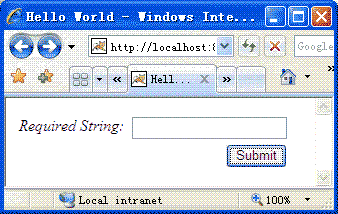
圖4 Input.jsp
直接點擊“Submit”提交表單,出現圖5所示的頁面。
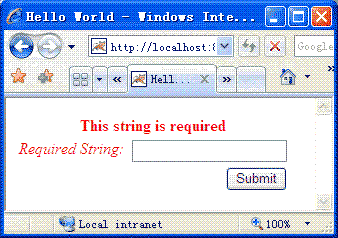
圖5 錯誤提示
在Required String中隨便填點東西,轉到Output.jsp頁面,如圖6所示。
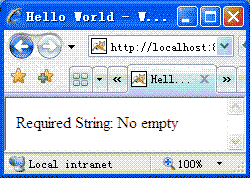
圖6 Output.jsp
通過上面的例子,大家可以看到使用該校驗框架十分簡單方便。不過,上例還有兩點不足:
- 還沒有國際化錯誤消息;
- 沒有實現客戶端的校驗。
當然,要完善以上不足,對于Struts 2.0來說,只是小菜一碟。
- 在Xxx-validation.xml文件中的<message>元素中加入key屬性;
- 在Input.jsp中的<s:form>標志中加入validate="true"屬性,就可以在用Javascript在客戶端校驗數據。
下面是具體的實現,首先在國際化資源文件中加入錯誤消息,然后按照上面說明實現。因為要使用Javascript在客戶端顯示出錯信息,所以在加載Input.jsp頁面時,Struts 2.0需要獲得國際化的字符串,故我們需要使用Action來訪問Input.jsp頁面,具體實現請參考《在Struts 2.0中國際化(i18n)您的應用程序》的最后部分。最后發布運行應用程序,直接在頁面中點擊“Submit”,表單沒有被提交并出現錯誤提示,如圖7所示:
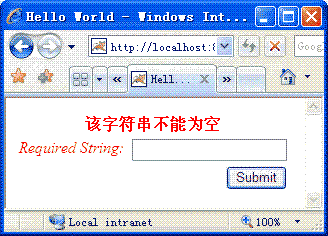
圖7 客戶端校驗
校驗框架是通過validation攔截器實現,該攔載被注冊到默認的攔截器鏈中。它在conversionError攔截器之后,在validateXxx()之前被調用。這里又出現了一個選擇的問題:到底是應該在action中通過validateXxx()或validate()實現校驗,還是使用validation攔截器?絕大多數情況,我建議大家使用校驗框架,只有當框架滿足不了您的要求才自已編寫代碼實現。
配置文件查找順序
在上面的例子中,我們通過創建ValidationAction-validation.xml來配置表單校驗。Struts 2.0的校驗框架自動會讀取該文件,但這樣就會引出一個問題——如果我的Action繼承其它的Action類,而這兩個Action類都需要對表單數據進行校驗,那我是否會在子類的配置文件(Xxx-validation.xml)中復制父類的配置嗎?
答案是不,因為Struts 2.0的校驗框架跟《在Struts 2.0中國際化(i18n)您的應用程序》提到的“資源文件查找順序”相似,有特定的配置文件查找順序。不同的是校驗框架按照自上而下的順序在類層次查找配置文件。假設以下條件成立:
- 接口 Animal;
- 接口 Quadraped 擴展了 Animal;
- 類 AnimalImpl 實現了 Animal;
- 類 QuadrapedImpl 擴展了 AnimalImpl 實現了 Quadraped;
- 類 Dog 擴展了 QuadrapedImpl;
如果Dog要被校驗,框架方法會查找下面的配置文件(其中別名是Action在struts.xml中定義的別名):
- Animal-validation.xml
- Animal-別名-validation.xml
- AnimalImpl-validation.xml
- AnimalImpl-別名-validation.xml
- Quadraped-validation.xml
- Quadraped-別名-validation.xml
- QuadrapedImpl-validation.xml
- QuadrapedImpl-別名-validation.xml
- Dog-validation.xml
- Dog-別名-validation.xml
已有的校驗器
Struts 2.0已經為您實現很多常用的校驗了,以下在jar的default.xml中的注冊的校驗器。
? ? < validator name ="required" class ="com.opensymphony.xwork2.validator.validators.RequiredFieldValidator" />
? ? < validator name ="requiredstring" class ="com.opensymphony.xwork2.validator.validators.RequiredStringValidator" />
? ? < validator name ="int" class ="com.opensymphony.xwork2.validator.validators.IntRangeFieldValidator" />
? ? < validator name ="double" class ="com.opensymphony.xwork2.validator.validators.DoubleRangeFieldValidator" />
? ? < validator name ="date" class ="com.opensymphony.xwork2.validator.validators.DateRangeFieldValidator" />
? ? < validator name ="expression" class ="com.opensymphony.xwork2.validator.validators.ExpressionValidator" />
? ? < validator name ="fieldexpression" class ="com.opensymphony.xwork2.validator.validators.FieldExpressionValidator" />
? ? < validator name ="email" class ="com.opensymphony.xwork2.validator.validators.EmailValidator" />
? ? < validator name ="url" class ="com.opensymphony.xwork2.validator.validators.URLValidator" />
? ? < validator name ="visitor" class ="com.opensymphony.xwork2.validator.validators.VisitorFieldValidator" />
? ? < validator name ="conversion" class ="com.opensymphony.xwork2.validator.validators.ConversionErrorFieldValidator" />
? ? < validator name ="stringlength" class ="com.opensymphony.xwork2.validator.validators.StringLengthFieldValidator" />
? ? < validator name ="regex" class ="com.opensymphony.xwork2.validator.validators.RegexFieldValidator" />
</ validators >
|
|
關于每個校驗器的具體用法,請參考以下鏈接: http://wiki.javascud.org/display/ww2cndoc/Validation 該鏈接中還有一些很有的信息,請大家仔細閱讀。 |
總結
使用校驗框架既可以方便地實現表單數據校驗,又能夠將校驗與Action分離,故我們應該盡可能使用校驗框架。在使用校驗框架時,請不要忘記通過在資源文件加入invalid.fieldvalue.xxx字符串,顯示適合的類型轉換出錯信息;或者使用conversion校驗器。


 ? ?
? ?

